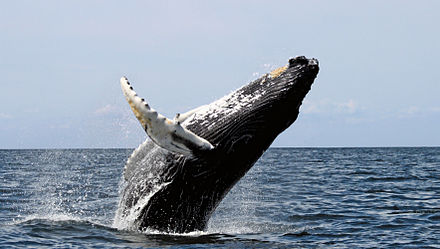
A humpback whale breaching
Wikipedia tells us this about whales:
Whales, derived from Proto-Germanic word hwæl, are a widely distributed and diverse group of fully aquatic marine mammals. They comprise the extant families Cetotheriidae (whose only living member is the pygmy right whale), Balaenopteridae (the rorqual whales), Balaenidae (right whales), Eschrichtiidae (the grey whale), Monodontidae (belugas and narwhals), Physeteridae (the sperm whale), Kogiidae (the dwarf and pygmy sperm whale), and Ziphiidae (the beaked whales).[1][2] There are 40 extant species of whales. The two suborders of whales, Mysticeti and Odontoceti, are thought to have split up around 34 million years ago.[3] Whales belong to the clade Cetartiodactyla and their closest living relative is the hippo having diverged about 40 million years ago.[4]
But I like whales because they are:
Their are some key parts to a whale's anatomy that I think are interesting:

A humpback whale breaching

Whale jumping out of water